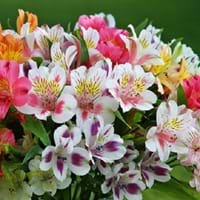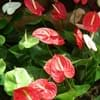Life Span
Annual
Perennial
Type
Tender Perennial
Flowering Plants, Herbs
Origin
South America, Argentina, Chile
Hybrid origin
Types
Not Available
Not Available
Number of Varieties
Not Available
Habitat
Cultivated Beds
moist forests, Mountains
USDA Hardiness Zone
8-11
4-9
Sunset Zone
H1, 5, 6, 7, 8, 9, 14, 15, 16, 17, 18, 19, 20, 21, 22, 23, 24
1a, 1b, 2a, 2b, 3a, 3b, 4, 5, 6, 7, 8, 9, 10, 11, 12, 13, 14, 15, 16, 17, 18, 19, 20
Habit
Clump-Forming
Clump-Forming
Flower Color
Light Pink, Lavender, Orange Red
Purple, Pink, Lavender
Flower Color Modifier
Multi-Color
Bicolor
Fruit Color
Yellow green
Brown
Leaf Color in Spring
Light Green, Gray Green
Green
Leaf Color in Summer
Light Green, Gray Green
Green
Leaf Color in Fall
Light Green, Gray Green
Green
Leaf Color in Winter
Gray Green, Yellow green
Green
Leaf Shape
Lanceolate
Pinnate
Plant Season
Summer
Spring, Summer
Sunlight
Full Sun, Partial Sun
Full Sun
Type of Soil
Loam, Sand
Clay, Loam, Sand
The pH of Soil
Acidic, Neutral
Acidic, Neutral, Alkaline
Soil Drainage
Well drained
Well drained
Bloom Time
Early Summer, Summer, Late Summer
Late Spring, Summer
Tolerances
Drought
Drought, Salt
Where to Plant?
Ground
Ground
How to Plant?
Seedlings
Cuttings, Seedlings
Plant Maintenance
Medium
Medium
Watering Requirements
Requires regular watering
Needs very little water
In Summer
Lots of watering
Lots of watering
In Spring
Moderate
Moderate
In Winter
Average Water
Average Water
Soil pH
Acidic, Neutral
Acidic, Neutral, Alkaline
Soil Type
Loam, Sand
Clay, Loam, Sand
Soil Drainage Capacity
Well drained
Well drained
Sun Exposure
Full Sun, Partial Sun
Full Sun
Pruning
Remove damaged leaves, Remove dead branches, Remove dead leaves
cut main trunk every 5 years, Prune after flowering, Prune central stem, Remove damaged leaves, Remove dead branches, Remove dead leaves
Fertilizers
All-Purpose Liquid Fertilizer
All-Purpose Liquid Fertilizer, Apply 5-10-5 amounts, Compost
Pests and Diseases
Red blotch
Nematodes, Red blotch, Trunk Rot
Plant Tolerance
Drought
Drought
Flower Petal Number
Single
Single
Fragrant Bark/Stem
Not Available
No
Foliage Texture
Fine
Medium
Foliage Sheen
Matte
Glossy
Attracts
Hummingbirds
Butterflies, Leaf Hoppers
Allergy
angioedema, Rhinoconjunctivitis, Throat itching, Urticaria
Itchiness, Not Available, Sore Throat
Aesthetic Uses
Showy Purposes
Beautification
Beauty Benefits
Not Available
Anti-ageing, Good Cleanser, Remove blemishes, Removes pimples
Environmental Uses
Air purification
Air purification, Food for animals, Food for birds, soil stabilisation
Medicinal Uses
Not Available
Cough, Haemorrhages, Laxative, Obesity, Tonic
Part of Plant Used
Flowers, Root
Fruits, Leaves
Other Uses
Decoration Purposes
Added to salads, Can be boiled and seasoned, pickled, Culinary use
Used As Indoor Plant
No
No
Used As Outdoor Plant
Yes
Yes
Garden Design
Cutflower, Mixed Border
Container, Cutflower, Mixed Border, Rock Garden / Wall, Wildflower
Botanical Name
ALSTROEMERIA ligtu
Averrhoa bilimbi
Common Name
Lily-of-the-Incas, Peruvian-lily
Bilimbi, Mimbro
In Hindi
peruvian lily
Bilimbi
In German
peruanische Lilie
bilimbi
In French
lis des Incas
bilimbi
In Spanish
lirio peruano
bilimbi
In Greek
περουβιανή κρίνος
bilimbi
In Portuguese
lírio peruano
bilimbi
In Polish
peruwiański lilia
bilimbi
In Latin
Peruviani lilium
Rondo Beardtongue
Phylum
Magnoliophyta
Magnoliophyta
Class
Liliopsida
Magnoliopsida
Order
Liliales
Oxalidales
Family
Liliaceae
Oxalidaceae
Genus
Alstroemeria
Averrhoa
Clade
Angiosperms, Monocots
Angiosperms, Eudicots, Rosids
Tribe
Not Available
Not Available
Subfamily
Not Available
Not Available
Importance of Peruvian-Lily and Bilimbi
Want to have the most appropriate plant for your garden? You might want to know the importance of Peruvian-Lily and Bilimbi. Basically, these two plants vary in many aspects. Compare Peruvian-Lily and Bilimbi as they differ in many characteristics such as their life, care, benefits, facts, etc. Every gardener must at least have the slightest clue about the plants he wants to plant in his garden. Compare their benefits, which differ in many ways like facts and uses. The medicinal use of Peruvian-Lily is Not Available whereas of Bilimbi is Cough, Haemorrhages, Laxative, Obesity and Tonic. Peruvian-Lily has beauty benefits as follows: Not Available while Bilimbi has beauty benefits as follows: Not Available.
Compare Facts of Peruvian-Lily vs Bilimbi
How to choose the best garden plant for your garden depending upon its facts? Here garden plant comparison will help you to solve this query. Compare the facts of Peruvian-Lily vs Bilimbi and know which one to choose. As garden plants have benefits and other uses, allergy is also a major drawback of plants for some people. Allergic reactions of Peruvian-Lily are angioedema, Rhinoconjunctivitis, Throat itching and Urticaria whereas of Bilimbi have Itchiness, Not Available and Sore Throat respectively. Having a fruit bearing plant in your garden can be a plus point of your garden. Peruvian-Lily has no showy fruits and Bilimbi has no showy fruits. Also Peruvian-Lily is not flowering and Bilimbi is not flowering . You can compare Peruvian-Lily and Bilimbi facts and facts of other plants too.





